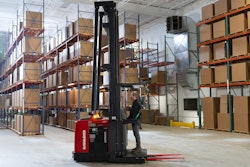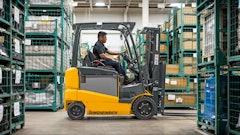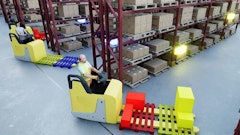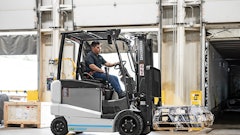
Wood, plastic or steel? Today’s food companies have a number of pallet choices.
Advancing technologies continue to move every industry toward ever-increasing optimizations in production, quality and cost efficiencies. Pallet providers are responding to these advances by rethinking how their products and services can help their customers meet the rigors of pallet passage throughout the food supply chain with cost-effective solutions.
Highly automated material handling equipment—such as automatic retrieval systems, robotics, and laser-guided driverless forklifts—subject today’s pallets to a more rigorous journey through the supply chain than ever before. Consequently, a gentle debate now exists in the pallet industry concerning the superiority of one material over another and whether wood, the leading pallet material for generations, should be replaced with plastic or steel.
But even plastic pallets do not escape the debate; critics cite them as being just as prone to the rigors of the supply chain. Of course, providers of a particular material have a vested interest in that one material.
We asked providers of wood, plastic and steel pallets to note a few top requirements their customers are seeking in pallet products and services. The consensus is that customers today want a whole lot more and they want it for less.
Quality and dimensional precision: Highly automated material handling equipment, designed to increase productivity, is putting pressure on shipping platforms for dimensional precision and a higher-quality platform, notes Derek Hannum, director of marketing for Orlando, FL-based CHEP USA. The company maintains a pool of 75 million predominately wood pallets in the U.S.; it also uses plastic and wood pallets throughout the world.
Steve Letnich at Worthington Steelpac Systems submits that the rigors of today’s supply chain undermine the consistent quality and dimensional precision of wood pallets. “We believe you will see a significant move from wood toward alternative materials in the next few years,” says Letnich, vice president of sales and marketing for the York, PA-based company. Letnich reports the company has 50,000 pallets in circulation throughout the U.S., and that the number is growing daily.
Service and management: For Yonkers, NY-based PECO Pallet Inc., it’s all about setting standards, says David Lee, CEO. “We see ourselves as professionals in setting standards we want to provide to our customers.”
The company maintains a national network of 120 sub-contracted third-party pallet recycler depots for its pool of 3.5 million wood pallets. These depots inspect, repair, and issue pallets according to PECO Pallet standards.
“We don’t put a limit on how many we will repair,” claims Lee. The company also maintains a service team to anticipate and resolve any customer needs quickly.
Another facet of service customers want is a closed-loop returnable supply, says Letnich at Worthington. The company’s galvanized steel pallets are the first of their kind on the market providing edge-rackable pallets exceeding GMA standards, adds Letnich.
Orlando, Florida-based iGPS Co. provides the first pallet rental service offering all-plastic pallets with embedded RFID tags, says Bob Moore, chairman and CEO, a former global chief executive for CHEP. The RFID tags are multi-use tags, explains Moore.
“There is a pallet serial number and other data that we use to track and trace these assets. Some of our customers use the RFID tags to put away and retrieve products from their racks with their automated retrieval systems,” says Moore. “So the RFID tags were designed to accommodate our needs to track and trace our assets as well as to accommodate our customers’ requirements to identify their SKUs to particular pallets.”
The pallets with their RFID tags and barcodes are also easy to trace if a food-safety problem or product recall arises, simplifying administration and accounting procedures, he adds.
Hannum at CHEP adds that customers are choosing pooling options more today. “It is still a small percentage of the pallet market, which is dominated by one-way shipments. But pooling is popular with major manufacturers in the consumer packaged goods market because of the service we offer. They know there is 100 percent reliability for a uniform product and the pallets will be there when they need them.”
He adds that CHEP’s Portfolio Plus, an e-business customer portal, allows customers to manage their accounts online in real time. “Our large customers move tens of thousands of pallets out of their facilities every day, so reporting is an important activity for them. Managing all of that online saves them time and money.”
Cost: Lee at PECO Pallet explains the company is “very clear on what the price point is and we are eager to make sure we are competitive with that while delivering the high-quality wooden platform the industry expects. We also give the assurance that we will maintain that quality over time through our depot network.”
Justifying pallets as assets aids in per-use costing, advises Letnich at Worthington. “More people are examining their true costs related to one-way and disposable wood pallets. Leasing, pooling, or outright purchasing can offer huge cost savings.”
Renting is a smart choice vs. buying pallets outright and maintaining a pallet fleet, says Moore at iGPS, a manufacturer and provider of plastic pallets with a pool of five million pallets in the U.S. “Our customers don’t have to carry any assets on their books and they can rent our pallets for about four cents a day. When pallets get to their destination, we retrieve and inspect them for reuse.”
Pallets are turned five times a year. “So it’s the same as having 25 million one-way pallets,” says Moore.
MEETING CUSTOMER REQUIREMENTS
Wood pallets: Hannum at CHEP reports that its parent company, Brambles, recently announced a $160 million commitment to improve the quality of products and services in the US market.
“This means we will deliver consistent platforms every time. We currently repair a percentage of those and we will remove the variability of that repair process so every pallet performs optimally, regardless of the level of automation within a customer’s operation. This is quite a significant financial investment, especially in light of the current economic market,” he says.
CHEP is “material agnostic,” says Hannum. “Wood just happens to be an excellent material because it is renewable, recyclable, and offers an excellent strength-to-weight cost ratio.”
The company has tested every available material in its Orlando testing lab, but has not found an alternative to wood that solves the equation involving durability, racking strength, cost, and repairability, reports Hannum. CHEP recently introduced a repairable pooled plastic pallet in China and is testing its economics on a small scale in the U.S.
“We just haven’t seen a commercially available plastic pallet out there that will stand up over the long term to the rigors of a U.S. pooled wood pallet,” says Hannum.
Providers of alternative pallets point to drawbacks in wood, such as insect or bacteria contamination and material breakdown that can cause supply chain interruptions. “You really can’t talk in terms of absolutes,” argues Hannum. “I think the track record for wood pallets speaks for itself and we don’t know of any contamination being traced to a wood pallet.”
Lee at PECO Pallet reports the industry has long indicated a demand for alternative materials. “I looked at many plastic pallets but, unfortunately, they all failed for one reason or another. They are expensive, so they don’t meet the industry’s cost requirement,” says Lee, one of the six original people to launch CHEP in the U.S.
According to Lee, about 70 percent of the food and beverage market is serviced by leasing programs offered by CHEP, PECO Pallet and iGPS. The remaining 30 percent of the market is serviced by white wood programs.
“We ask our customers to help us understand their supply chains by telling us how many pallets they need to lease from us and where their supply chains extend so we can develop a competitive and economic proposal.”
Plastic pallets: Sustainability is another advantage over wood, says Moore at iGPS. “Five years out, plastic pallets will win over wood because of plastic’s lighter weight and consistency in size, which lends well to automation. Plastic is also impervious to liquids and cleans easily.”
Steel pallets: Currently, about 10 percent of pallets are made from steel, says Worthington’s Letnich. “Although wood is the primary material for pallets, the markets for steel and plastic pallets are growing.”
Worthington produces corrosion-resistant galvanized steel distribution pallets. “They are the first and only GMA-certified edge-rackable, reusable steel pallet,” reports Letnich. Steel pallets are commonly used in closed-loop operations so companies can keep track of these assets, says Letnich. They are also used in DCs as in-house pallets.
Letnich acknowledges that wood controls a large part of the industry. “Wood does a good job and it has been doing so for a long time,” he says. “But today there are reliable and easily manufactured alternatives that can fit different segments within the supply chain. For instance, companies shipping overseas might choose steel to avoid the bug infestation problems that exist with wood.”
RFID ON THE RADAR
Moore at iGPS predicts that within five years, all pallets will carry RFID tags in the interest of automation. “Barcodes require human intervention because you have to wand the barcode. But RFID can read the serial number without human intervention once the equipment has been set up.”
CHEP’s Hannum worked with the Auto ID Center at MIT when it was first established in 1999. “The real value of RFID as a network model happens where there are many nodes in the network, but there is a major investment required to get that done,” he says.
Although there is not widespread adoption at any level yet in the U.S., Hannum points to successful overseas installations.
“Tagging pallets is only half the battle because you have to have the readers and other infrastructure in place to get any value out of the tags. We have the capability to do RFID, but we still haven’t seen that magic cost benefit breakthrough in a mainstream way,” says Hannum.



















